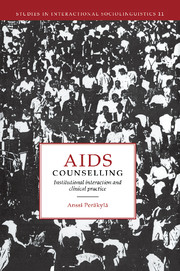Book contents
- Frontmatter
- Contents
- Preface
- Transcription conventions
- 1 Introduction
- 2 Quasi-conversational turn-taking
- 3 The client as owner of experience
- 4 The management of co-counsellors' questions
- 5 Some interactional uses of co-counsellors' questions
- 6 Addressing ‘dreaded issues’
- 7 The interactional power of hypothetical questions
- 8 Conclusion
- Appendix: the data base
- References
- Index
2 - Quasi-conversational turn-taking
Published online by Cambridge University Press: 02 December 2009
- Frontmatter
- Contents
- Preface
- Transcription conventions
- 1 Introduction
- 2 Quasi-conversational turn-taking
- 3 The client as owner of experience
- 4 The management of co-counsellors' questions
- 5 Some interactional uses of co-counsellors' questions
- 6 Addressing ‘dreaded issues’
- 7 The interactional power of hypothetical questions
- 8 Conclusion
- Appendix: the data base
- References
- Index
Summary
Counsellors of the Royal Free Hospital once described the method of AIDS counselling based on Family Systems Theory as follows: ‘questions are used in order to explore different perceptions and views of relationships’ (Bor and Miller 1988: 400).
As the quotation above indicates, a central feature of this method of AIDS counselling is its extensive reliance on questions and answers. Counsellors help clients to deal with the social and psychological strains caused by the illness, and prepare them mentally for possible worsening of their condition at some future time. This is done in the first place by asking the clients questions. The counsellors at the Royal Free Hospital also believe that AIDS-related problems are embedded in a complex system of relations and perceptions; and that making the clients aware of these can be helpful for them. Invoking this kind of awareness is also done through questions.
Asking questions is not, however, the only thing that the counsellors do during the sessions. There are many issues that the clients have to be informed and advised about. These include the details of the transmission of the virus and of safer sex, and medical issues related to the meaning of different symptoms and to various drug trials that take place at the clinic. Counsellors also have knowledge about the different social services that are available for HIV-positive patients; many clients need to be told about these, too.
Therefore, on a general level, it can be said that the tasks of the counsellors are accomplished through two types of turns of talk: (1) questions and (2) informative and advisory statements.
- Type
- Chapter
- Information
- AIDS CounsellingInstitutional Interaction and Clinical Practice, pp. 37 - 102Publisher: Cambridge University PressPrint publication year: 1995



